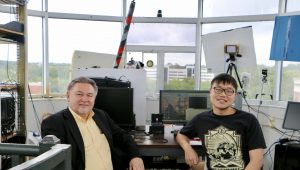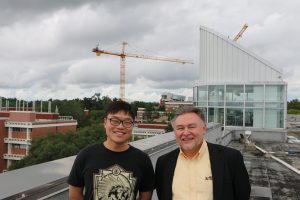ECE Professor and Co-Director of the International Center for Lightning Research & Testing (ICLRT) Vladimir Rakov has been awarded a $1M grant from the National Science Foundation (NSF) for his project, “Lightning Studies Based on Measurements Spanning the Ranges from Radio Frequency to Optical (including Infrared and Ultraviolet) to Gamma-Rays.”

Much of the work will be done at the Lightning Observatory in Gainesville (LOG), a facility which includes the glass cupola on top of the New Engineering Building (NEB), providing a more than 180° unobstructed view of the horizon. The cupola houses digitizing oscilloscopes, computers, and high-speed video cameras. In addition, various sensors—electric field antennas, electric field derivative antennas, magnetic field derivative antennas, and x-ray/gamma-ray detectors—are located nearby on the roof. Data from all of these devices are recorded continuously, filling local and cloud servers managed by the department.
The Project
The work will include optical observations of lightning in an unprecedentedly wide wavelength range using a unique array of high-speed framing cameras. These include: traditional visible-range cameras, medium-to-far infrared (IR) cameras, and near-ultraviolet (UV) range cameras. Data from x-ray/gamma ray detectors, and electric & magnetic field antennas are recorded simultaneously.
It’s this wealth of data across the entire EM spectrum that makes the project unique—masses of data can then be synced and merged for an unprecedentedly detailed view of each lightning event.
Each device captures its particular signature: IR images will provide a measure of temperature in different parts of the lightning channel, while UV images will make it possible to detect “cold” lightning processes (such as corona streamer bursts) which play a fundamental role in determining lightning behavior. Using this suite of devices (cameras, sensors, and detectors) to record each lightning event, researchers will be able to ‘see’ lighting in new and incredibly detailed ways.
The research will potentially impact many areas/disciplines, including:
- lightning physics
- the global electric circuit (the corona is one of the key processes that keep the Earth negatively charged)
- cloud electrification (corona at ground may be a significant contributor to the formation of the lower positive charge region)
- high-energy atmospheric physics (corona streamer bursts produce x- and gamma-rays)
- lightning protection (corona-emitting systems sometimes are claimed to control the lightning termination point)
- thunderstorm warning (occurrence of corona is an indicator of thunderstorm hazard)

Key to the research is a newly obtained and specially modified UV camera. It will allow the targeting of the streamer zone of descending leader branches and that of upward unconnected leaders. Then, the possibility of imaging the common streamer zone formed during the lightning attachment process and the lightning channel corona sheath will be explored.
The project is aimed at answering the following new science questions:
- What is the role of corona streamers in the various phenomena associated with thunderstorms and lightning?
- What can we learn from direct comparison of high-speed recordings of lightning in the IR, visible, and UV ranges?
- What processes (besides the attachment process) create recently observed loops in the lightning channel?
- How fundamental are the differences between positive and negative lightning?
The Facility
The Lightning Observatory in Gainesville (LOG), Florida, is an internationally-recognized facility, part of the ICLRT (International Center for Lightning Research and Testing). Dr. Rakov and Dr. Martin A. Uman are Founding Co-Directors of the center. The observatory is presently the only active part of the ICLRT and is operated by Dr. Rakov and his graduate students. Since 2004, more than 40 peer-reviewed journal papers have been published based on the results obtained at LOG.